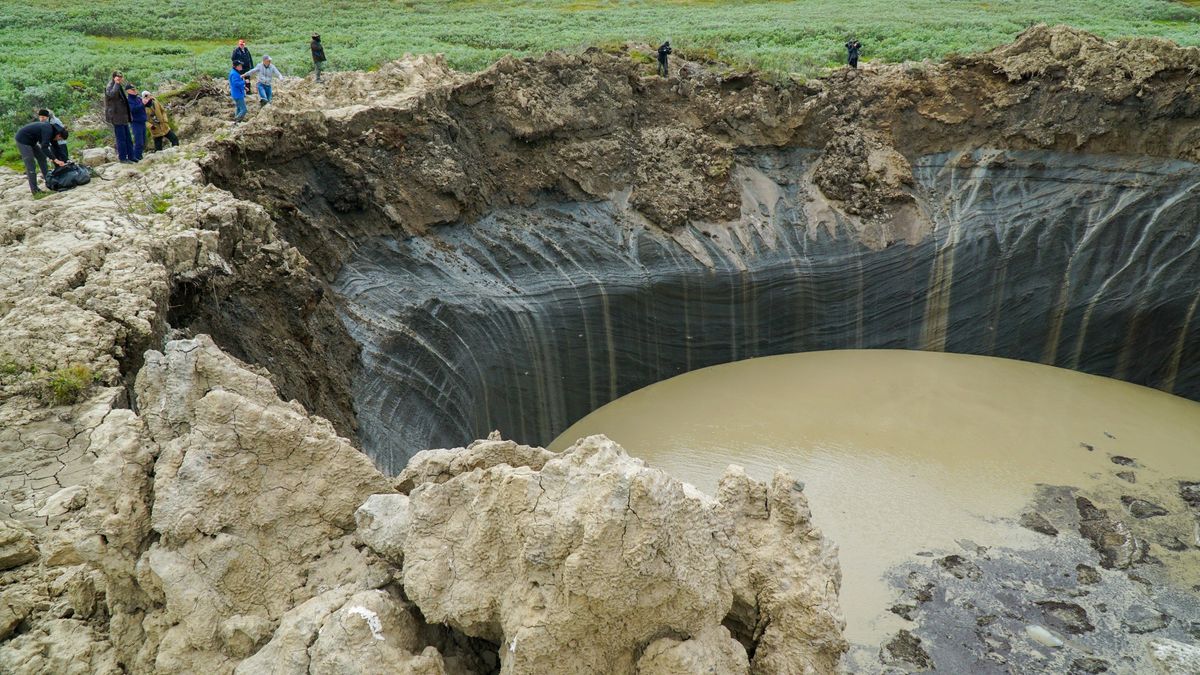Mysterious “frost mounds” dotted across Siberia sometimes burst to form giant craters — and now, scientists have taken a step closer to discovering what makes these strange humps pop.
Frost mounds are areas of the permafrost that bulge as fluids accumulate beneath the surface. According to ongoing research at the Siberian Branch of the Russian Academy of Sciences (SBRAS), two distinct “systems” can lead to this bulging: open and closed. In an open system, water and gas pooling beneath the permafrost move around and leak to the surface through cracks. But in a closed system, water and gas are trapped in a pocket that inflates, putting increasing pressure on the permafrost.
The open system is similar to an idea researchers put forward earlier this year. In a preprint review published Jan. 12 to the EarthArXiv database, the scientists argued that natural gas moving between the bedrock and overlying permafrost leads to melting from below. This melting creates pockets in the permafrost where fluids can accumulate, but these are not completely sealed off from the gas beneath or from the surface. The pockets grow as more gas flows into them, leading to more melting and a rise in pressure, which causes the ground to swell.
The gas is mostly thermogenic methane, which likely forms continuously as a by-product when organic matter heats up. “We call it a kitchen [down there], because it’s kind of like cooking, and it’s creating gas,” Helge Hellevang, a professor of environmental geosciences at the University of Oslo in Norway and lead author of the preprint review, told Live Science.
In a closed system, gas and water come from deep within the bedrock. The fluids rise and form a pocket inside the permafrost that is “surrounded by frozen rocks on all sides,” according to SBRAS researchers, and therefore does not leak out.
Related: Underwater robot in Siberia’s Lake Baikal reveals hidden mud volcanoes — and an active fault
Despite the distinction between open and closed systems, there is nothing to stop one from morphing into the other as the permafrost evolves, Hellevang said. An open system may even need to become closed before it can form a crater, he said.
Scientists still aren’t sure exactly how gas accumulates to form frost mounds, but they know the mounds can rupture spontaneously and open up huge holes in the permafrost. The Yamal crater, measuring about 65 feet (20 meters) wide and 165 feet (50 m) deep, is one example. A helicopter pilot spotted the crater 26 miles (42 kilometers) from the Bovanenkovo gas field on Russia’s northern Yamal Peninsula in 2014. Since then, scientists have documented seven more of these giant craters across the Yamal and neighboring Gydan peninsulas.
Researchers with SBRAS said frost mounds “explode” to form the craters, but Hellevang disagrees. Explosions require a source of ignition, such as high heat or electricity, but “it’s very hard to ignite the gas at sub-zero,” he said. “It’s more like an eruption than an explosion.”
It’s possible open systems could create the pressure necessary for an eruption, but that would require very low gas flow rates out of the system, Hellevang said. Closed systems are more likely to trigger eruptions, as they have a bigger buildup of pressure right away, he said.
Both systems may have a heightened risk of eruption as temperatures rise and thaw the permafrost, Hellevang said. “Climate change is weakening the surface through thawing from the top,” he said. At some point, the permafrost becomes so thin it cannot withstand the pressure from pockets of gas below, which could spark eruptions.
Sudden gas eruptions pose a risk to people that live on the Yamal and Gydan peninsulas and to infrastructure like gas pipelines. Another big concern, Hellevang said, is that “if the permafrost is a lid for all this massive amount of methane … then these craters might also in the future be pathways for more methane leakages.” And that could trigger even more warming, he said.











/https://tf-cmsv2-smithsonianmag-media.s3.amazonaws.com/filer_public/34/31/3431771d-41e2-4f97-aed2-c5f1df5295da/gettyimages-1441066266_web.jpg)








Discussion about this post